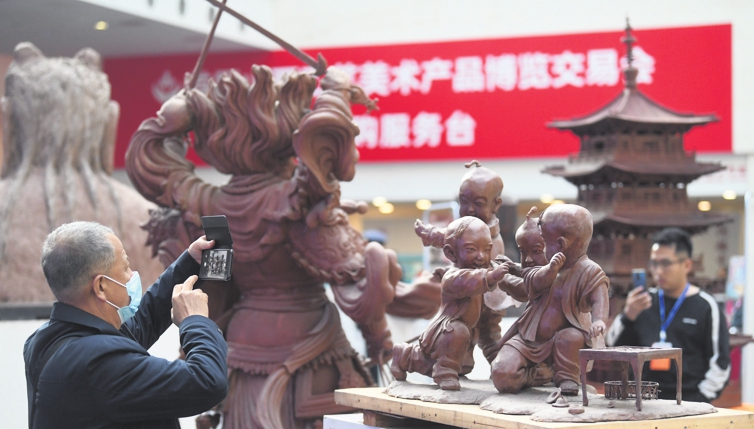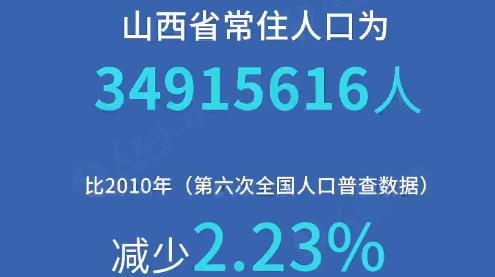
Visitors take pictures of clay sculptures at the Shanxi Handicraft Expo.ZHONG QING / FOR CHINA DAILY
Ren Qi, a resident in Hejin city in the southwest of Shanxi, drove nearly four hours to the provincial capital of Taiyuan to attend the Shanxi Handicraft Expo that opened on Oct 15.
Ren brought his son with him, expecting to show him the three precious cultural treasures of Shanxi and other art forms and explain to him the cultural value embodied in the handicrafts on display.
The "three treasures of Shanxi" refers to fahua ware, hand-polished lacquerware and chengni ink slab.
Fahua ware, which is mostly made in the south of Shanxi, is the porcelain version of cloisonne, where the design elements are separated by copper wires. Porcelain featuring these techniques is fired at lower temperatures with the different colored glazes and enamels applied to individual areas created by the slip lines.
Known as one of the top four lacquerwares in China, the lacquerware in Pingyao county, especially the hand-polished variety, is a brilliant representation of the craft in China.
The hand-polished lacquerware of Pingyao is made of a natural raw lacquer and varnished by hand using a special technique.
Through embedding, sculpting, carving and colored painting, the lacquerware is decorated with patterns of mountains and rivers, flowers and birds, figures and pavilions.
As one of the top four ink slabs in China, chengni ink slabs produced in Jiangxian county, are a favorite of Chinese enthusiasts in calligraphy and traditional painting.
Unlike other ink slabs that are made from natural stone, chengni is produced by firing silt-rich clay collected from riverbeds. The ink slabs also feature elegant shapes and delicate engravings, which make them valuable pieces of art.
At the exhibition hall, Ren told his son that the production techniques of two of the treasures, fahua ware and chengni ink slab, had been lost for more than a century. But contemporary craftsmen have revived the techniques over the past three decades.
There were also a raft of other handicrafts on display, including brick, stone and wood carvings, and Buddha statues.
But Ren and his son, as well as other visitors, were mostly impressed by the handicrafts and folk arts commonly seen in daily life.
The exhibition areas for paper-cutting, flour sculpture and clay sculpture were crowded with people. Ren and his son closely watched the artists at work and bought one or two items as souvenirs of a fun day out learning about the handicrafts of Shanxi province.
Li Yali contributed to this story.
By YUAN SHENGGAO
 山西路橋:黨建引領 建好“四好農村路”山西路橋建設集團黨委扎實開展“黨建質量提升年”,實施“六大工程”,立足“十四五”高質量、高速度、高效益發展的戰略基點,全面提高黨建質量和黨建引領發展水平,為打造“國內一流的交通基礎設施投資、建設、施工現代化企業集團”提供堅強政治保障。
山西路橋:黨建引領 建好“四好農村路”山西路橋建設集團黨委扎實開展“黨建質量提升年”,實施“六大工程”,立足“十四五”高質量、高速度、高效益發展的戰略基點,全面提高黨建質量和黨建引領發展水平,為打造“國內一流的交通基礎設施投資、建設、施工現代化企業集團”提供堅強政治保障。
 常住人口3491萬 山西人口普查數據"出爐"山西省統計局向社會通報山西省第七次全國人口普查主要數據。數據顯示,山西省常住人口為34915616人,比2010年(第六次全國人口普查數據,下同)減少2.23%,年平均減少0.23%。山西省常住人口總量減少,主要受人口流動變化等因素影響。
常住人口3491萬 山西人口普查數據"出爐"山西省統計局向社會通報山西省第七次全國人口普查主要數據。數據顯示,山西省常住人口為34915616人,比2010年(第六次全國人口普查數據,下同)減少2.23%,年平均減少0.23%。山西省常住人口總量減少,主要受人口流動變化等因素影響。